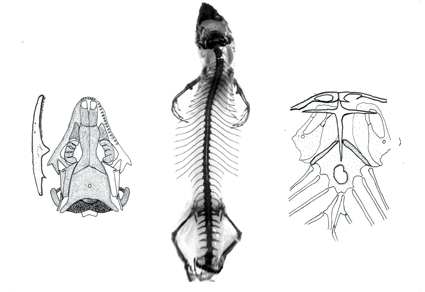Abstract
A total of 230 cleared and alizarin stained and 136 radiographed specimens of Darevskia belonging to 47 nominal taxa (species, subspecies or singular clades) including the seven parthenogenetic ones and a triploid hybrid were studied. Sixteen osteological characters in all the tried species were analyzed. These characters by corporal regions were: skull characters: 1.—number of premaxillary teeth; 2.—number of maxillary teeth; 3.—number of dentary teeth; 4.—teeth morphology; 5.—presence of anterolateral process in the postfrontal bone; 6.—presence of anteromedial process in the postorbital bone; 7.—comparative lengths of the postorbital and postfrontal bones; 8.—overlap degree between the postorbital and the squamosal bones. Postcranial characters: 9.—existence of visible (ossified) ribs associated with the third presacral vertebrae; 10.—sternal/xiphisternal costal formula and presence of inscriptional ribs; 11.—number of presacral vertebrae; 12.—number of posterior dorsal vertebrae (short presacral ribs); 13.—presence and form of the sternal fontanelle; 14.—form of the clavicles (emarginated or marginated); 15.—interclavicle form; 16.—morphology of first autotomic vertebrae of the tail.
Our goals were to characterize osteologically the different species of Darevskia, to contrast their relationships traced from osteological traits with the available genetic-derived phylogenies of the group, to compare the osteological characteristics of the parthenogenetic species with their bisexual parental species, and to comment on their parentage and character polarity. Finally, we aimed to search for osteological characteristics of the different groups within Darevskia, diagnosing them for the first time. The results, commented on by characters, are available in the main text, and taxa characteristics are easily consultable and condensed in Table 1.
Osteological characteristics of Darevskia, together with available phylogenetic trees, have permitted us to define some new groups within Darevskia (raddei, chlorogaster, defilippi, and parvula new groups) (Appendix 3), which are reciprocally monophyletic and have diagnostic characteristics. All of them are diagnosed and named as subgenera to be used if necessary, instead of the partial, old and not always comprehensive groups.
References
- Arribas, O., Ilgaz, Ç., Kumlutaş, Y., Durmus, S.H., Avcı, A. & Üzüm, N. (2013) External morphology and osteology of Darevskia rudis (Bedriaga, 1886), with a taxonomic revision of the Pontic and Small-Caucasus populations (Squamata: Lacertidae). Zootaxa, 3626 (54), 401–428. http://dx.doi.org/10.11646/zootaxa.3626.4.1
- Bischoff, W. (1973) Lacertenbastarde II. Zoologischer Garten, 43 (5), 278–291
- Ciobanu, D.G., Grechko, V.V. & Darevsky, I.S. (2003) Molecular evolution of satellite DNA CLsat in lizards from the Genus Darevskia (Sauria: Lacertidae): Correlation with species diversity. Russian Journal of Genetics, 39 (11), 1292–1305. https://doi.org/10.1023/B:RUGE.0000004145.00165.ee
- Darevsky, I.S. (1966) Natural parthenogenesis in a polymorphic group of Caucasian rock lizards related to Lacerta saxicola Eversmann. Journal of the Ohio Herpetological Society, 5 (4), 115–152. http://dx.doi.org/10.2307/1562588
- Darevsky, I.S. (1967) Rock lizards of the Caucasus (Systematics, Ecology and Phylogenesis of the polymorphic groups of Rock lizards of the Subgenus Archaeolacerta. Nauka press. Leningrad. 216 pp. [Translation: New Delhi: Indian National Scientific Documentation Centre, 276 pp].
- Darevsky, I.S. & Kulikova, W.N. (1961) Natürliche Parthenogenese in der polymorphen Gruppe der kaukasischen Felseidechse (Lacerta saxicola Eversmann). Zoologische Jahrbücher. Abteilung für Systematik, Geographie und Biologie der Tiere, 89, 119–176
- Darevsky, I.S., Uzzell, T., Kupriyanova, L.A. & Danielyan, F.D. (1973) Triploid hybrid males in sympatric populations of some parthenogenetic and bisexual species of rock lizards of the genus Lacerta. Bulletin of Moscow Society of Naturalists, 78 (1), 48–58.
- Darevsky, I.S. & Vedmederja, V. (1977) A new species of rock lizard Lacerta saxicola Eversmann group from northeastern Turkey and adjoining regions of Adjaria. Trudy Zoological Institute Akademia, 74, 50–54.
- Darevsky, I.S.; Kupriyanova, L. & Uzzell, T. (1985) Parthenogenesis in Reptiles. In: Gans, F. & Billet, F. Biology of the Reptilia. Vol 15, Development B. Wiley, pp. 411–526.
- Darevsky, I.S., Kupriyanova, L.A. & Danielyan, F.D. (1986) New evidence of hybrid males of parthenogenetic lizards. In: Rocek, Z. Studies in Herpetology. pp. 207–211.
- Darevsky, I.S. & Tuniyev, B.S. (1997) A new lizard species from Lacerta saxicola group – Lacerta dryada sp. nov. (Sauria, Lacertidae) and some comments relative to Lacerta clarkorum Darevsky et Vedmederja, 1977. Russian Journal of Herpetology, 4, 1–7. https://doi.org/10.30906/1026-2296-1997-4-1-1-7
- Doronin, I.V., Tuniyev, B.S. & Kukushkin, O.V. (2013) Differentiation and taxonomy of the rock lizards Darevskia (saxicola) complex (Sauria: Lacertidae) according to morphological and molecular analyses. Proceedings of the Zoological Institute of the Russian Academy of Sciences, St. Petersburg, 317 (1), 54–84.
- Freitas, S.M.R.N. de (2017) Why Sex? Darevskia answers. Programa Doutoral em Biodiversidade, Genética e Evolução. Universidade do Porto, 245 pp.
- Fu, J., Darevsky, I.S., MacCulloch, R.D., Kupriyanova, L.A., Roitberg, E.S., Sokolova, T.M. & Murphy, R.W. (1995) Genetic and morphological differentiation among Caucasian rock lizards of the Lacerta caucasica complex. Russian Journal of Herpetology, 2 (1), 36–42. https://doi.org/10.30906/1026-2296-1995-2-1-36-42
- Fu, J., Murphy, R.W. & Darevsky, I.S. (1997) Towards the phylogeny of Caucasian rock lizards: implications from mitochondrial DNA gene sequences. Zoological Journal of the Linnean Society, 120 (4), 463–477. https://doi.org/10.1111/j.1096-3642.1997.tb01283.x
- Gabelaia, M., Tarknishvili, D. & Adriaens, D. (2018) Use of three-dimensional geometric morphometrics for the identification of closely related species of Caucasian rock lizards (Lacertidae: Darevskia). Biological Journal Linnean Society, 2018, XX, 709–717. https://doi.org/10.1093/biolinnean/bly143
- Mayer, W. & Lutz, D. (1989) Chemosystematische Untersuchungen zur Phylogenese der Sammelgattung Lacerta (Reptilia: Sauria: Lacertidae). Journal of Zoological Systematics and Evolutionary Research, 27 (4), 338–349. https://doi.org/10.1111/j.1439-0469.1989.tb00357.x
- Mertens, R. (1964) Über Reptilienbastarde, III. Senckenbergiana biologica, 45 (1), 33–49.
- Murphy, R.W., Fu, J., MacCulloch, R.D., Darevsky, I.S. & Kupriyanova, L.A. (2000) A fine line between sex and unisexuality: the phylogenetic constraints on parthenogenesis in lacertid lizards. Zoological Journal of the Linnean Society, 130, 527–549. https://doi.org/10.1111/j.1096-3642.2000.tb02200.x
- Orlova, V.F. (1979) Geographic Variation and Description of the Lectotype of Artvinian Lizard Lacerta derjugini Nik. Collected Papers of the Zoological Museum of Moscow State University, vol. 17, 188–203.


